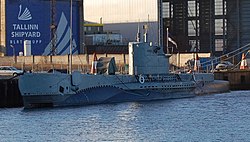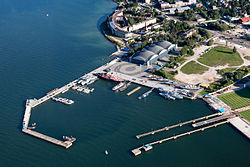Lennusadam | |
 Entrance to the museum | |
 | |
| Established | 12 May 2012 |
|---|---|
| Location | Vesilennuki 6, Tallinn, Estonia |
| Coordinates | 59°27′02″N24°44′18″E / 59.450433°N 24.738308°E |
| Type | Maritime museum |
| Key holdings | EML Lembit |
| Visitors | 321,700 (2014) [1] |
| Director | Urmas Dresen |
| Nearest parking | On site (no charge) |
| Website | www.lennusadam.ee |
The Seaplane Harbour (Estonian: Lennusadam) is a maritime museum in Tallinn, Estonia, which opened in spring 2012. [2] The museum is part of the Estonian Maritime Museum. [3]
Contents
The museum is located in the Tallinn aeroplane harbour, in a building originally constructed as a hangar for seaplanes in the area of Peter the Great's Naval Fortress. The hall has an area of 8,000 m2 (86,000 sq ft) and was put out of service during the Soviet era. Its renovation started in 2010; it was 70% funded by the European Regional Development Fund and 30% by the Estonian state. [2]






